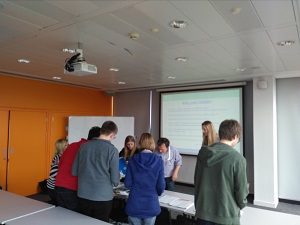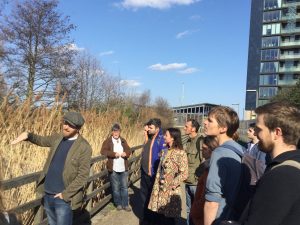What exactly does it mean to be a Member Network Convenor? By Craig Llewellyn
BLOG
Our Member Networks are run by volunteer members, so every committee is a bit different and probably no two weeks are the same – but that’s what makes it so exciting! Craig Llewellyn ACIEEM, Convenor of CIEEM’s South East England Section Committee and Senior Ecologist at AECOM, gives us some highlights of what he gets up to as Convenor.
If you’re inspired by this, hop on over to the Members’ area to find out more about how you can get involved. The call for nominations for the 2019 Elections closes on 20 September.
Week 1
Monday morning, there is a busy work week ahead; I’ve just had an email from one of our Committee members to say they are in contact with senior planners at South Downs National Park. The Park is forming a new local plan, and we have the opportunity to collaborate on a talk for CIEEM members to discuss their new policies, including promoting a landscape-led approach and securing ecosystems services and Biodiversity Net Gain. This type of collaboration between LPA and CIEEM South East is common, extending CIEEM’s reach and giving members the opportunity to input into the development of new policies that are directly relevant to our profession.
 On Thursday I attend Reigate Grammar School to put up a CIEEM stand. The age group is 14-16 year olds and it was a good opportunity to talk to them about environmental careers and gain an insight as to what direction they expect to go in life. It’s amazing that, even at this stage, some have a good idea where they want to go. It’s really inspiring and fills me with hope for the next generation of environmentalists.
On Thursday I attend Reigate Grammar School to put up a CIEEM stand. The age group is 14-16 year olds and it was a good opportunity to talk to them about environmental careers and gain an insight as to what direction they expect to go in life. It’s amazing that, even at this stage, some have a good idea where they want to go. It’s really inspiring and fills me with hope for the next generation of environmentalists.
Week 2
It’s Wednesday and today is my first CIEEM Advisory Forum meeting. These only occur twice a year, but are a good opportunity for me as Convenor to bring views and issues relevant to the region for discussion at the meeting, which is attended by the CEO, President, and Advisory Forum members, including Section Convenors from across the UK and Ireland.
which is attended by the CEO, President, and Advisory Forum members, including Section Convenors from across the UK and Ireland.
The topics discussed included likely changes to the CIEEM Competency Framework, and how we can fit Biodiversity Net Gain and UK Habitat Classification into current practices. We talked about the new Registered Practices scheme, and how we can help members understand its purpose and ensure it is a fair system for all members.
We also discussed how we can engage more with members at different stages of their career, and how we can aim to commission research and/or gather evidence on areas of professional practice to benefit our members.
It was exciting to be a part of this important link between members and our Institute, providing a sense of fulfilment that I’m doing my bit, and hopefully influencing positive changes to the Institute along the way.
Week 3
Over the weekend the Government has announced a consultation on Biodiversity Net Gain, including whether to make it mandatory. It’s a national consultation that has gathered a lot of interest from all parties on how we can implement it and provide a standardised approach that can be adopted by environmental professionals through the planning process.
Emailing round the Committee, we decide to organise a get-together to discuss the consultation, using our expertise to provide a response that will feed into the CIEEM Policy Team’s own national response to the consultation. We meet at the London Borough of Southwark and have a good discussion on the benefits and drawbacks of Biodiversity Net Gain. We spend time going through the consultation questions using the wealth of experience on the Committee, ranging from consultancy, local planning authority, academia and NGO backgrounds. We formulate a response, which was well received by the CIEEM Policy Team. It was a good team building exercise to learn how to respond to such consultations in the future.
Week 4
It’s Thursday, and we are off to the University of Reading to give a presentation to their MSc students. As a Committee, we have good contacts within universities in the region and pride ourselves on engaging with students and forming relationships with academia. Our talk informs students about CIEEM, career opportunities, online career resources, and what we can do to help. Student feedback is positive; it’s tricky breaking into the environment sector, so any guidance we can give is always appreciated by budding young professionals.
 Saturday and our Annual South East Meeting is being held at Greenwich Peninsula Ecology Park in south London, in which we have collaborated with the Land Trust and the Conservation Volunteers. It’s a good turnout of members, including our whole Committee. We have inspiring talks from a variety of speakers, from both NGOs and LPA backgrounds. Paul Hetherington (Buglife) talked about their ‘B-lines’ project and the importance of pollinators and invertebrate areas in the South East.
Saturday and our Annual South East Meeting is being held at Greenwich Peninsula Ecology Park in south London, in which we have collaborated with the Land Trust and the Conservation Volunteers. It’s a good turnout of members, including our whole Committee. We have inspiring talks from a variety of speakers, from both NGOs and LPA backgrounds. Paul Hetherington (Buglife) talked about their ‘B-lines’ project and the importance of pollinators and invertebrate areas in the South East.
Peter Massini (Greater London Authority) gave a talk about Urban Greening, building a picture of how we need to move away from seeing wildlife areas as separate from development, but integrated and part of it.
The Greenwich Peninsula Ecology Park was the focus for Simon Pile (Land Trust) who explained how the park is completely ‘unnatural’ with a whole range of artificially created habitats and an interesting water management system. We rounded off the day with guided tours of the park. Attendee feedback was positive and we all learnt throughout the day!
Final thoughts…
Whilst not every week as Convenor is this active, I hope this account has shown the diversity of tasks we undertake as a Committee, as well as the breadth of commitment we have for our region in providing the best experience we can to both members and potential-members. I would also hope that it shows how open we are to connecting with external organisations, from public bodies to academia. We can work together to better our profession, and all play a part in raising standards in ecology and environmental management across the board.
Blog posts on the CIEEM website are the views and opinions of the author(s) credited. They do not necessarily represent the views or position of CIEEM. The CIEEM blog is intended to be a space in which we publish though-provoking and discussion-stimulating articles.
